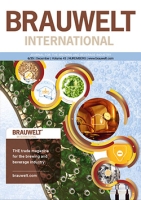Think of selling beer in a hot country where most people live on less than two dollars a day and you will understand that there’s something going on when beer consumption drops more than 60 per cent and then starts to rebound.
As described in Brauwelt International, No. 6, 2007, page 387, for the areas of production and filling, it is necessary to systematically examine all steps involved in the “development history” of beer because something may have changed in some way in every area. Part 2 provides suggestions and pointers for the area of energy and water utilities. More in-depth calculations and details can be found in the Brauwelt and Brauwelt International issues cited.
In planning or extending a brewery, it is necessary to systematically examine all steps involved in the “development history” of beer, because (practically) every change or addition in the production and filling area, in whatever form, will affect each of these areas, and impinge on energy and water utilities. This paper provides suggestions, advice and orientation assistance for domestic and foreign installations. More detailed calculations and details can be found in the Brauwelt and Brauwelt International issues cited. This first part covers the production and filling area, Part 2 to follow will deal with energy and water utilities.
This article discusses the gluten content of various beers and two beer-based mixed beverages, determined using two different enzyme immunoassays. Evaluations of the test results for gluten content, interpreted within the scope of legal guidelines governing food products, show that beer brewed solely with barley malt and the beer-based mixed beverages (Shandy, Cola-beer mix) created from it, do not contain relevant amounts of gluten.
Never mind the sun, sand and sea, “what’s to drink?” The Caribbean, once the domain of Martinis, Daiquiris, Mojitos, Piña Coladas, Cuba Libres and a host of Planter’s Punches, is gradually turning into a beer eldorado, with breweries operating on even the smallest of islands. Anyone for a sundowner? Make mine a beer, please.
The objective of a mobile configuration of information flow within company processes is to reduce costs. Expenses calculated for a stationary configuration of information flow can thus be compared with those for a mobile configuration. A detailed analysis of actual and target state form the basis, both for the decision itself as well as for monitoring during the period of use.
The presence of carbon dioxide in beer influences the pH value. Models have been derived that convert with great accuracy the pH value of carbonized beer into the value of the degassed sample. The pH value measurement was integrated into a new modular measurement system. Apart from the pH value, this modular measurement system, without sample preparation, also determines the alcohol concentration, the density, the carbon dioxide percentage and the color of carbonized beer.
A new non-invasive and non-destructive fibre optic oxygen meter determines oxygen permeability of plastic bottles and containers by measuring trace concentrations of oxygen as it passes through the package wall. Ideal for production and QC/QA testing applications, this system incorporates the latest in optical-chemical sensor technology. Permeation rates can be confirmed without piercing the package or bottle. Oxygen ingress or seal integrity can be verified as it occurs in standard packaging process.
Sometimes strategic business planning can turn into an existential dilemma. Just ask the Ajegroup’s executives, Peru’s upstart soft drinks company. They not only dared to enter the oligopolist Mexican soft drinks market but also announced plans to diversify into brewing.
Using parameters for sizing of compressor capacity and condenser capacity on the basis of hl of sales beer produced per day, it is possible to evaluate the performance of the installed refrigeration plant without problems at any time, and not just during peak production months. This calculation check can show whether bottlenecks exist and whether a more accurate calculation of refrigeration requirements is necessary.


